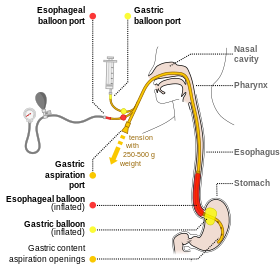| Mr. Ibrahem/Esophageal balloon tamponade | |
|---|---|
 Drawing of using the Blakemore tube. There is a
manometer connected to the esophageal port, to enable inflating the balloon with correct pressure. | |
| Specialty | Emergency medicine, gastroenterology |
| Uses | Variceal bleeding (esophageal or stomach) [1] |
| Complications | Airway obstruction, esophageal rupture [1] |
| Types | Sengstaken-Blakemore, Minnesota, Linton [2] |
Esophageal balloon tamponade refers to the use of balloon tamponade in the esophagus and stomach. [1] This is generally carried out to treat bleeding from esophageal or gastric varices when other measures are not available or not successful. [1]
The most common cause of bleeding from varices is cirrhosis. [1] These devices are generally only used in people who are hemodynamically unstable. [1] Contraindications for placement include recent esophageal surgery or esophageal stricture. [1]
Preparation involves intubation followed by placing the person on their back at 45 degrees. [1] The device is than checked to make sure no leaks are present. [1] It is than placed via the mouth and 50 ml of air are added to the stomach balloon. [1] An X-ray is than done to verify placement and once confirmed more air is added. [1] Traction can than be applied. [1] Bleeding is than checked for, and if present the esophageal balloon may be inflated using a manometer. [1]
After placement, further treatment is required. [1] Complications can include airway obstruction, esophageal rupture, and aspiration pneumonia. [1] The procedure is rarely done. [1] The first device developed was the Sengstaken-Blakemore tube in the 1950s. [1] Other versions of the device include the Minnesota tube and the Linton tube. [1] [2]
References
- ^
a
b
c
d
e
f
g
h
i
j
k
l
m
n
o
p
q
r
s
t Powell, M; Journey, JD (January 2021). "Sengstaken-Blakemore Tube".
PMID
32644350.
{{ cite journal}}: Cite journal requires|journal=( help) - ^ a b "Esophageal Balloon Tamponade". fpnotebook.com. Archived from the original on 22 January 2021. Retrieved 15 March 2021.